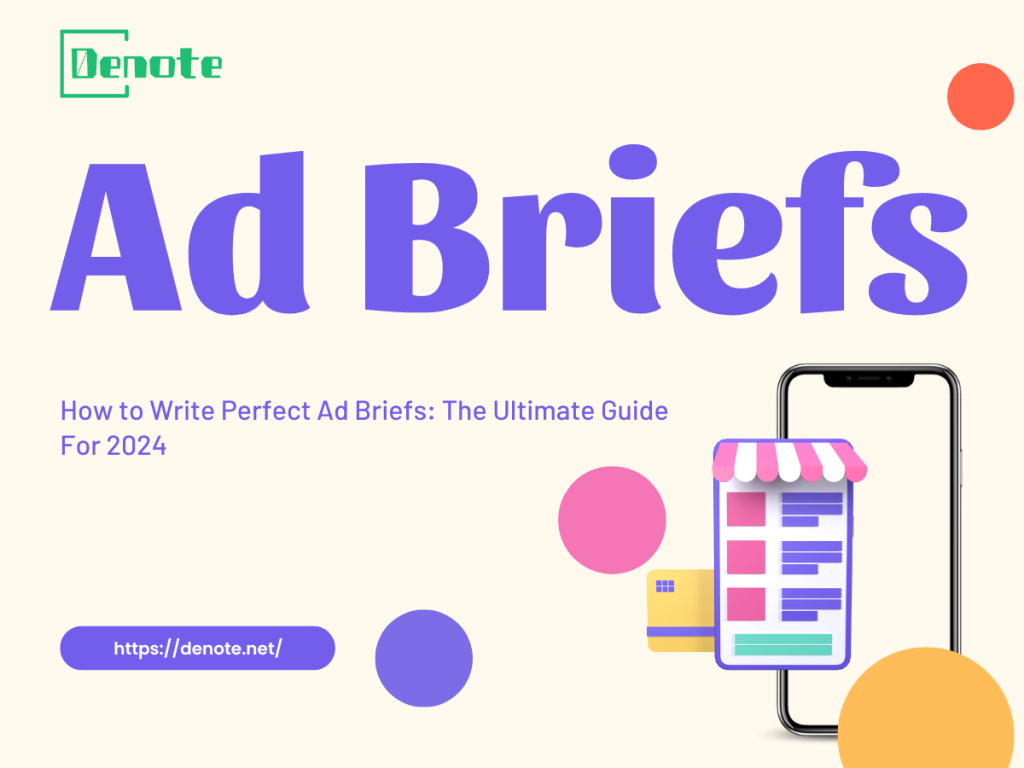How to Write Perfect Ad Briefs: The Ultimate Guide For 2024

What is the ad brief
An ad brief is a fundamental document that outlines the strategy and essential details for an advertising campaign. It serves as a guide for the creative team, providing a clear understanding of the project's goals, target audience, key messages, and deliverables. The ad briefs ensures that everyone involved in the project is aligned and working towards the same objectives.
Why are ad briefs so crucial for creative projects
Ad briefs are crucial for creative projects because they provide a structured framework that helps streamline the creative process. By clearly defining the project's objectives, target audience, and key messages, ad briefs ensure that the creative team can focus their efforts on producing work that is both relevant and impactful. This alignment minimizes misunderstandings and revisions, ultimately saving time and resources while enhancing the quality and effectiveness of the final output.
8 Essential elements of ad briefs
Project Overview
Ad briefs begin with a concise project overview, providing a snapshot of the campaign's purpose, background, and context. This section sets the stage for the creative team by outlining what the campaign aims to achieve and why it's important.
Objectives
The objectives section of ad briefs outlines the specific goals the campaign aims to accomplish. Whether it's increasing brand awareness, driving sales, or launching a new product, clearly defined objectives serve as the guiding light for all creative decisions and strategies.
Target Audience
Ad briefs delve into the target audience, providing detailed insights into who they are, what motivates them, and how they behave. Understanding the demographics, psychographics, and preferences of the target audience is crucial for crafting messages and creative assets that resonate and drive engagement.
Key Message
Within ad briefs, the key message is the central idea or theme that the campaign seeks to communicate to the target audience. This message should be clear, compelling, and aligned with the overall objectives of the campaign. It serves as the foundation upon which all creative elements are built.
Brand Positioning
Ad briefs articulate the brand's positioning within the market and its unique value proposition. This section highlights the brand's strengths, values, and personality, helping to differentiate it from competitors and create a distinct identity that resonates with the target audience.
Tone and Style
Ad briefs specify the tone and style that should be reflected in the campaign's creative assets. Whether it's playful and humorous or professional and authoritative, establishing the right tone ensures consistency across all communication channels and helps to reinforce the brand's image and messaging.
Deliverables and Timeline
Ad briefs outline the deliverables required for the campaign, including the types of media (e.g., print, digital, social) and specific formats (e.g., ads, videos, banners). Additionally, they include a timeline with key milestones and deadlines to ensure that the project stays on track and meets its objectives in a timely manner.
Budget and Approval
Finally, ad briefs detail the budget allocated for the campaign and the approval process. This section outlines the resources available for creative development and distribution and identifies the key stakeholders responsible for reviewing and approving the final deliverables before launch.
3 Free ad briefs templates
Simple Ad Briefs Template
Project Overview:
Project Title: [Title of the Campaign]
Background: Ad Briefs overview of the campaign's context and objectives.
Objectives:
Primary Goal: [Main objective of the campaign]
Secondary Goals: [Additional objectives, if any]
Target Audience:
Demographics: [Age, gender, location, etc.]
Psychographics: [Interests, behaviors, values, etc.]
Key Message:
Main Message: [Core message/theme of the campaign]
Supporting Points: [Additional messages to reinforce the main message]
Brand Positioning:
Brand Values: [Key values and principles of the brand]
Brand Personality: [Traits and characteristics that define the brand]
Tone and Style:
Tone: [Desired mood or attitude for the campaign]
Style: [Specific stylistic guidelines for creative assets]
Deliverables and Timeline:
Formats: [Types of media and specific formats required]
Milestones and Deadlines: [Key dates and deadlines for each phase]
Budget and Approval:
Total Budget: [Overall budget allocated for the campaign]
Approval Process: [Stakeholders responsible for approval and criteria]
Comprehensive Ad Briefs Template
Project Overview:
Project Title: [Title of the Campaign]
Background: Detailed Ad Briefs overview of the campaign's purpose, target audience, and objectives.
Objectives:
Primary Goal: [Main objective of the campaign]
Secondary Goals: [Additional creative brief objectives, if any]
Target Audience:
Demographics: [Age, gender, location, etc.]
Psychographics: [Interests, behaviors, values, etc.]
Audience Insights: [Key insights about the target audience]
Key Message:
Main Message: [Core message/theme of the campaign]
Supporting Points: [Additional messages to reinforce the main message]
Brand Positioning:
Brand Values: [Key values and principles of the brand]
Brand Personality: [Traits and characteristics that define the brand]
Tone and Style:
Tone: [Desired mood or attitude for the campaign]
Style: [Specific stylistic guidelines for creative assets]
Deliverables and Timeline:
Formats: [Types of media and specific formats required]
Quantities: [Number of each deliverable]
Milestones and Deadlines: [Key creative brief dates and deadlines for each phase]
Budget and Approval:
Total Budget: [Overall budget allocated for the campaign]
Breakdown: [Detailed breakdown of budget allocation]
Approval Process: [Stakeholders responsible for approval and criteria]
Video Production ad Briefs Template
Project Overview:
Project Title: [Title of the Video]
Background: Provide ad briefs overview of the project, including the context, history, and why the video is being produced.
Purpose: Clearly state the purpose of the video (e.g., promotional, educational, training, etc.).
Objectives:
Primary Goal: Define the main objective of the video (e.g., increase brand awareness, explain a product, drive sales).
Secondary Goals: List any video creative briefs additional goals that support the primary objective.
Target Audience:
Demographics: Describe the age, gender, location, income, education level, etc., of the target audience.
Psychographics: Explain the interests, values, attitudes, and lifestyle of the audience.
Audience Insights: Include any key insights or behaviors relevant to the project.
Key Message:
Main Message: What is the core message you want to communicate through the video?
Supporting Points: Outline any additional points that support the main message.
Brand Positioning:
Brand Values: List the core values that should be reflected in the video.
Brand Personality: Describe the brand’s personality traits (e.g., friendly, professional, innovative).
Unique Selling Proposition: What sets your brand apart from competitors?
Tone and Style:
Tone: Specify the overall mood or attitude of the video (e.g., humorous, serious, inspirational).
Style: Define stylistic elements such as visual style, pacing, and design elements. Consider color schemes, fonts, and any visual motifs.
Creative Considerations:
Script and Storyboard: Include any initial ideas or requirements for the script and storyboard.
Visual References: Provide examples of other videos or styles that you like.
Special Requirements: Note any special requirements like animations, voice-overs, specific locations, or actors.
Deliverables and Timeline:
Deliverables: List the final outputs needed (e.g., full video, teaser clips, social media edits).
Formats: Specify the required formats and resolutions for each deliverable (e.g., 1080p, 4K, vertical format for social media).
Milestones and Deadlines: Detail the creative brief timeline with key milestones and final deadlines (e.g., script approval, filming dates, editing deadlines).
Budget:
Total Budget: Provide the overall budget for the project.
Breakdown: Offer a detailed breakdown of how the budget will be allocated (e.g., pre-production, production, post-production).
Approval Process:
Stakeholders: List the key individuals or groups who need to approve the creative work.
Approval Criteria: Outline the standards and criteria that the creative work must meet for approval.
Additional Information:
References: Include any additional resources or references that may be helpful (e.g., brand guidelines, previous videos, market research).
Contact Information: Provide contact details for key project members and stakeholders.
Conclusion
Ad briefs are a fundamental document that outlines the strategy and essential details for an advertising campaign, serving as a guide for the creative team to provide a clear understanding of the project's goals, target audience, key messages, and deliverables.
By ensuring alignment and focused efforts, ad briefs are crucial for streamlining the creative process, minimizing misunderstandings and revisions, and ultimately enhancing the quality and effectiveness of the final output. Site:denote





